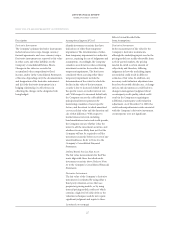American Express 2009 Annual Report Download - page 24
Download and view the complete annual report
Please find page 24 of the 2009 American Express annual report below. You can navigate through the pages in the report by either clicking on the pages listed below, or by using the keyword search tool below to find specific information within the annual report.
2009 FINANCIAL REVIEW
AMERICAN EXPRESS COMPANY
CRITICAL ACCOUNTING POLICIES
Refer to Note 1 to the Consolidated Financial Statements for a summary of the Company’s significant accounting policies
referenced, as applicable, to other notes. The following chart provides information about five critical accounting policies that are
important to the Consolidated Financial Statements and that require significant management assumptions and judgments.
RESERVES FOR CARDMEMBER LOSSES
Description Assumptions/Approach Used
Effect if Actual Results Differ
from Assumptions
Reserves for cardmember losses relating to
cardmember loans and receivables represent
management’s best estimate of the losses
inherent in the Company’s outstanding
portfolio of loans and receivables.
Reserves for cardmember loans and
receivables losses are primarily based upon
models that analyze portfolio performance
and reflect management’s judgment
regarding overall reserve adequacy. The
analytic models take into account several
factors, including average losses and
recoveries over an appropriate historical
period. Management considers whether to
adjust the analytic models for specific
factors such as increased risk in certain
portfolios, impact of risk management
initiatives on portfolio performance and
concentration of credit risk based on factors
such as tenure, industry or geographic
regions. In addition, management adjusts
the reserves for losses for other external
environmental factors including leading
economic and market indicators such as the
unemployment rate, Gross Domestic
Product (GDP), home price indices, non-
farm payrolls, personal consumption
expenditures index, consumer confidence
index, purchasing manager’s index,
bankruptcy filings, and the legal and
regulatory environment. Generally, due to
the short-term nature of cardmember
receivables, the impact of the other external
environmental factors on the inherent losses
within the cardmember receivable portfolio
is not significant. As part of this evaluation
process, management also considers various
reserve coverage metrics, such as reserves as
a percentage of past-due amounts, reserves
as a percentage of cardmember loans and
receivables, and net write-off coverage.
Cardmember loans and receivables are
written off when management deems
amounts to be uncollectible and is generally
determined by the number of days past due.
Cardmember loans and USCS cardmember
receivables are generally written off when
(continued on next page)
To the extent historical credit
experience updated for emerging
market trends in credit are not
indicative of future performance, actual
losses could differ significantly from
management’s judgments and
expectations, resulting in either higher
or lower future provisions for losses, as
applicable.
As of December 31, 2009, an
increase in write-offs equivalent to 20
basis points of cardmember loan and
receivable balances at such date would
increase the provision for cardmember
losses by approximately $133 million.
This sensitivity analysis does not
represent management’s expectations of
the deterioration in write-offs but is
provided as a hypothetical scenario to
assess the sensitivity of the provision for
cardmember losses to changes in key
inputs.
The process of determining the
reserve for cardmember losses requires a
high degree of judgment. It is possible
that others, given the same information,
may at any point in time reach different
reasonable conclusions.
22
























